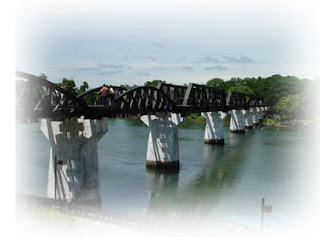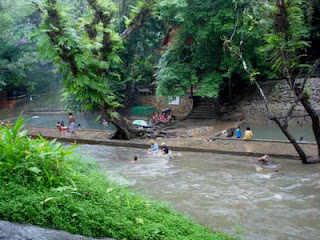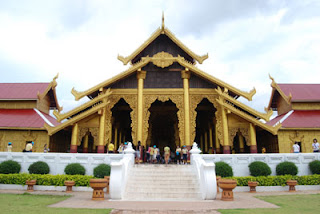
Thursday, January 24, 2008
Friday, January 18, 2008
WoW !!!! This is Saiyok Yai Waterfall




Situated near the office of Saiyok Nationl Park. The park covers approximately 300 square kilometers and contains several interesting caves and the nation’s famous Saiyok Yai Waterfall. The park has dense forests, including majestic teak trees and an abundance of small mammals such as squirrels, bats and deer, as well as numerous bird species. A rope bridge enables people to cross the river to view the waterfall. Rafts are available for a river trip along the riverbank but advance booking is recommended. Saiyok Yai Waterfall is 104 kilometers from town, by going future Saiyok Noi Waterfall 40 kilometers. Bungalow accommodations, river rafts, camping facilities, and a daytime food market are available.
Wednesday, January 16, 2008
We are going to Erawan Waterfall



Situated in Erawan Nation Park is 65 km. from town along Highway No.3199. The park, covering 550 square km., is the site of the 7-tiered Erawan Waterfall, one of Thailand’s loveliest waterfalls. The second tier has a pool, which is ideal for swimming and is particularly picturesque. However, the most popular activity in the park is trekking. Bungalow and camping facilities and a daytime food market are available. Visitors may take a bus from the Kanchanaburi Bus Station to the waterfall every 50 minutes from 8.00 a.m. to 5.20 p.m. The journey take 1.5 hrs., last bus back from the falls 4.00 p.m.
Saturday, January 12, 2008
Three Pagodas Pass


This pass is located approximately 240 kilometers from the city or 22 kilometers from Sangkhlaburi. The 3 miniature pagodas are memorials of the important routing of a strategic military for both Thai and Burmese. However, it is currently a small border market. The three miniature pagodas are memorials to the traditional invasion route favored by Burmese soldiers during the Ayutthaya period (1350-1767). Visitors wishing to visit Myanmar and advised to obtain a pass, which allows visitors to visit Burmese settlements from Sangkhlaburi Immigration Office, but foreigners can’t get stamp or extend new visa. Foreign Tourists have to pay 10 US.$ to Burmese to get in Myanmar. The border opens between 8.00 a.m. – 6.00 p.m. depending on the political situation.
Muang Badan (Underworld)

This is the Old Wangwiwegaram Temple, which was sunk in the lake from the construction of Vachiralongkorn Dam in 1979. Luang Pho Uttama, the Chief Monk of the temple rebuilt the new Wangwiwegaram Temple on the bank of river in Amphoe Sangkhlaburi. So, the old temple becomes to the underworld, wonderful architecture and beautiful nature surrounding. It would appear the old temple up in dry season, ebbing waters in the reservoir. To get to the underworld (Muang Badan), approximately 1-2 hrs. by long tail boat or house boat from Sangkhlaburi town along Songkalia River.
Thursday, January 10, 2008
Wednesday, January 9, 2008
Wat Wang Wiwekaram

The temple situated near Mon Brige, approximately 225 kilometers away from Kanchanaburi town. This extensive temple on the southern outskirts of Sangklaburi edges on Khao Laem reservoir. The complex is constructed in an unusual mix of Thai, Indian, and Burmese Buddhist architectural styles, and the abbot “Luang Pho Uttama” is highly revered among local people, Thai, Karen, Mon, including tribal folk and Burmese.
Read more : www.kanchanaburicity.com
Tuesday, January 8, 2008
Wat Tham Suea
Welcome to Kanchanaburi

Kanchanaburi,which has mostly mpuntainous terrain,covers an area of approximately 19,483.2 square kilometers and is the third largest province in Thailand after Nakhon Ratchsima and Chiang Mai. Situated approximately 129 kilometers west of Bangkok, Kanchanaburi shares a boder with Myanmar to the west, Tak and Uthai Thani Provinces to the north, Suphan Buri and Nakhon Pathom Provinces to the east, and Ratchaburi Province to the south.
The Bridge over the River Kwae
The internationally famous bridge, as part of the Death Railway linking Thailand and Myanmar, During the Japanese occupation of Thailand in World War II, the Japanese Imperial Army brought the iron bridge from Java. It was then resembled by Allied Prisoners of War (POW) under Japanese supervision. The bridge was part of a strategic railway rote to Myanmar in which the Japanese aimed to secure supplies with which to conquer other western Asian coutries.
Read more : www.kanchanaburicity.com
Wat Pa Luangta Bua Yannasampanno (Tiger Temple)
Wat Pa Luangta Bua Yannasampanno (Tiger Temple)

Located in Tambon Singh, about 45 k.m. away from the city. The temple is well known by many reports of Western and Thai media, for its “Wildlife Rescue Project”. Due to the illegal hunting and wildlife trading, someone is taking of animals from the jungle to be kept as pets.
Read more : www.kanchanaburicity.com

Located in Tambon Singh, about 45 k.m. away from the city. The temple is well known by many reports of Western and Thai media, for its “Wildlife Rescue Project”. Due to the illegal hunting and wildlife trading, someone is taking of animals from the jungle to be kept as pets.
Read more : www.kanchanaburicity.com
Prasat Mueang Sing Historical Park

Prasat Mueang Sing Historical Park
Muang Singh town was built between 857 and 1157 when the Khmer Kingdom was still prosperous. It was later abandoned until the reign of King Rama I
Read more : http://www.kanchanaburicity.com/
The Bridge over the River Kwae
The Bridge over the River Kwae

The internationally famous bridge, as part of the Death Railway linking Thailand and Myanmar, During the Japanese occupation of Thailand in World War II, the Japanese Imperial Army brought the iron bridge from Java. It was then resembled by Allied Prisoners of War (POW) under Japanese supervision. The bridge was part of a strategic railway rote to Myanmar in which the Japanese aimed to secure supplies with which to conquer other western Asian coutries.
Read more : www.kanchanaburicity.com
Welcome To Kanchanaburi
Welcome To Kanchanaburi

Kanchanaburi,which has mostly mpuntainous terrain,covers an area of approximately 19,483.2 square kilometers and is the third largest province in Thailand after Nakhon Ratchsima and Chiang Mai. Situated approximately 129 kilometers west of Bangkok, Kanchanaburi shares a boder with Myanmar to the west, Tak and Uthai Thani Provinces to the north, Suphan Buri and Nakhon Pathom Provinces to the east, and Ratchaburi Province to the south.
Read more : www.kanchanaburicity.com
Subscribe to:
Posts (Atom)





































